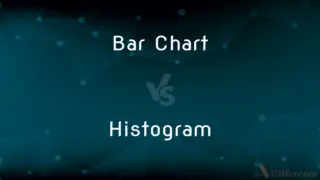Fe2O3 vs. Fe3O4 — What's the Difference?
By Tayyaba Rehman — Published on December 12, 2023
Fe2O3 is iron(III) oxide or hematite, while Fe3O4 is a mixed oxide known as magnetite or iron(II,III) oxide.

Difference Between Fe2O3 and Fe3O4
Table of Contents
ADVERTISEMENT
Key Differences
Fe2O3 and Fe3O4 are both iron oxides but differ in their iron and oxygen content. Fe2O3 is known as iron(III) oxide or hematite and has two iron atoms bonded to three oxygen atoms. On the other hand, Fe3O4 is called magnetite or iron(II,III) oxide and contains both ferrous (Fe2+) and ferric (Fe3+) iron ions with four oxygen atoms.
In terms of magnetic properties, Fe2O3 is weakly magnetic. In contrast, Fe3O4, because of its unique composition and structure, exhibits strong magnetic behavior, earning it the name "magnetite."
Fe2O3 and Fe3O4 also differ in terms of their color and appearance. Fe2O3 generally presents as reddish-brown, often found in soils and giving red hues to many rocks. Fe3O4, however, is usually black or dark brown, and its magnetic properties make it commonly used in magnetic recording and other similar applications.
From a practical perspective, Fe2O3 is widely used as a pigment because of its distinct color. It's a primary component in rust. Fe3O4, on the other hand, is exploited not just for its magnetic properties but also as a precursor in various industrial processes to produce iron.
Overall, while both Fe2O3 and Fe3O4 are iron oxides, they differ significantly in composition, structure, and application. Their unique properties lend them to varied uses in industries and natural processes.
ADVERTISEMENT
Comparison Chart
Chemical Name
Iron(III) oxide or Hematite
Magnetite or Iron(II,III) oxide
Composition
2 iron atoms, 3 oxygen atoms
3 iron atoms, 4 oxygen atoms
Magnetic Property
Weakly magnetic
Strongly magnetic
Color/Appearance
Reddish-brown
Black or dark brown
Common Use
Pigment, component in rust
Magnetic applications, iron production
Compare with Definitions
Fe2O3
Known as iron(III) oxide.
Rust, which gives a reddish-brown color, primarily consists of Fe2O3.
Fe3O4
Also called iron(II,III) oxide.
Fe3O4 contains both ferrous and ferric ions, hence its name iron(II,III) oxide.
Fe2O3
Contains two iron atoms bonded to three oxygen atoms.
The chemical formula Fe2O3 indicates two iron atoms for every three oxygen atoms.
Fe3O4
Recognized as magnetite.
Fe3O4, also known as magnetite, is used in magnetic tapes.
Fe2O3
Often presents a reddish-brown color.
The distinct color of Fe2O3 contributes to the color of red rocks and soils.
Fe3O4
Consists of three iron atoms bonded to four oxygen atoms.
The formula Fe3O4 denotes the presence of three iron atoms and four oxygen atoms.
Fe2O3
Commonly referred to as hematite.
Fe2O3, or hematite, is often used as a pigment in paints.
Fe3O4
Usually appears black or dark brown.
Fe3O4 has a blackish appearance, distinguishing it from other iron oxides.
Fe2O3
Exhibits weak magnetic properties.
Despite being an iron oxide, Fe2O3 is only weakly magnetic.
Fe3O4
Demonstrates strong magnetic behavior.
Due to its strong magnetism, Fe3O4 is used in various magnetic applications.
Common Curiosities
Is Fe2O3 the primary component in rust?
Yes, Fe2O3 is a primary component in rust.
What is the chemical name for Fe2O3?
Fe2O3 is called iron(III) oxide or hematite.
How is Fe3O4 commonly known in terms of its magnetic property?
Fe3O4 is commonly known as magnetite because of its strong magnetic behavior.
Which iron oxide is typically black or dark brown?
Fe3O4, or magnetite, is typically black or dark brown.
Why is Fe3O4 used in magnetic recording?
Fe3O4 exhibits strong magnetic properties, making it suitable for magnetic recording.
What is the significance of the name iron(II,III) oxide for Fe3O4?
The name iron(II,III) oxide indicates that Fe3O4 contains both ferrous (Fe2+) and ferric (Fe3+) iron ions.
Which iron oxide is commonly used as a pigment?
Fe2O3, or hematite, is commonly used as a pigment.
Are both Fe2O3 and Fe3O4 naturally occurring?
Yes, both Fe2O3 and Fe3O4 are naturally occurring minerals.
What is the relevance of the name hematite for Fe2O3?
Hematite is a mineral form of iron(III) oxide, or Fe2O3.
Does Fe2O3 exhibit strong magnetism?
No, Fe2O3 is only weakly magnetic.
Which of the two is often found in red rocks and soils?
Fe2O3, due to its reddish-brown color, is often found in red rocks and soils.
How do Fe2O3 and Fe3O4 differ in terms of oxygen content?
Fe2O3 has three oxygen atoms, while Fe3O4 has four.
How many iron atoms are present in Fe3O4?
Fe3O4 contains three iron atoms.
Can both Fe2O3 and Fe3O4 be used in the production of iron?
Yes, both Fe2O3 and Fe3O4 can be used as ores in the production of iron, but their processing methods might differ.
Is Fe3O4 the only iron oxide with strong magnetic properties?
While Fe3O4 is known for its strong magnetic properties, there are other iron oxides, but Fe3O4 is the most prominent.
Share Your Discovery

Previous Comparison
Judo vs. Jiu Jitsu
Next Comparison
Bar Chart vs. HistogramAuthor Spotlight
Written by
Tayyaba RehmanTayyaba Rehman is a distinguished writer, currently serving as a primary contributor to askdifference.com. As a researcher in semantics and etymology, Tayyaba's passion for the complexity of languages and their distinctions has found a perfect home on the platform. Tayyaba delves into the intricacies of language, distinguishing between commonly confused words and phrases, thereby providing clarity for readers worldwide.












































